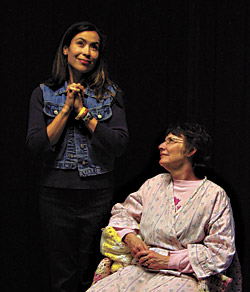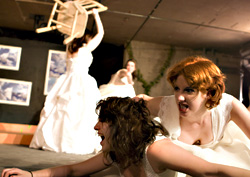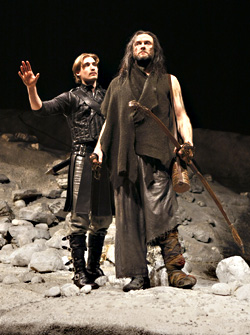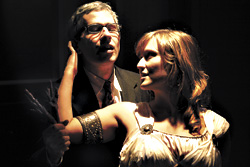AUTO FOCUS
directed by Paul Schrader
opens Oct. 23 at Metro and Uptown
Paul Schrader may be the smartest film critic who ever made it big in film: Taxi Driver, Raging Bull, and Affliction put him on a par with Truffaut. But even so, he is greatest when he talks about movies, not when he’s directing them. And even his best—including the new hit about Hogan’s Heroes star Bob Crane’s sexual death spiral, Auto Focus, which snapped Schrader out of his 20-year career death spiral—reveal a critic’s original sin: abstraction.
Sin is his abstract preoccupation. Like the George C. Scott character in his 1979 Hardcore, Schrader is a Calvinist from Grand Rapids who took the plunge from hard-core theology into Hollywood’s fleshpots. He’s like ex-trainee priest Dan Aykroyd, of whom a girlfriend says in Tom Shales’ SNL book, “His ultimate fantasy would be to commit a crime and arrest himself.” The enraged Calvinist dad and the defiant porn-star daughter in Hardcore are self-portraits. So is the De Niro character in Taxi Driver.
Auto Focus is enraged and amused by Crane’s sin: videotaping orgies with his Sony camera salesman and a zillion dim women drawn by Crane’s fame as Hogan, the cocky top G.I. in a Nazi P.O.W. camp. Crane was huge on TV in my 1960s youth, taming the Nazi nightmare with wiseacre style, heralding counterculture rebellion. On the Web site www.bobcrane.com (where you can watch his orgies), his weirdo son brags about Hogan’s long- running success.
BUT THIS MOVIE is about failure. Crane (ably reanimated by Greg Kinnear, who had a like cockiness to start with) is too much of a jerk-off to succeed at marriage—his porn habit drives away his prim, savvy childhood sweetheart (smartly played by Rita Wilson) and the bosomy blond co-star he dumped her for (Maria Bello in a vaguely written role). The real love story is between Crane and his video-gizmo guru John Carpenter (Willem Dafoe, toning down his trademark creepiness). Carpenter is half-Indian, and the idea is, he’s Tonto and Crane is the Masked Man. Behind the mask of the chipper, nice-guy star lurks a selfish obsessive who destroys everything in life in his quest of Girls Gone Wild.
Impressively, Schrader uses every tool of cinema to illustrate Crane’s gradual decline. The first scenes pack a finger-snappin’ Rat Pack punch; as sex dementia takes over, the colors, compositions, lighting, film stock, and camera work slip from bright to sleazy, rigidly Cartesian to Dostoyevsky-shaky-cam sloppy. The comedy is akin to that of the porn-mogul scenes in Hardcore (“Are these the numbers on Bang the Nun Slowly?”). Carpenter and Crane sit watching a tape of their orgy, bored and masturbating, kvetching about how they don’t like women, bickering when Crane sees that’s Carpenter’s finger up his butt, not the girl’s. “It was an orgy!” Carpenter whines.
THERE IS AN EXTREME deadpan excellence to this humor, but it is flat, like everything in Schrader’s universe. His style is less like an orgy participant’s spontaneity than a porn director’s numb, sterile obsessiveness. His pace, as in his other movies, is a relentless, single-minded march. His characters are ideas of characters, fancifully painted balsa-wood figures pushed around to illustrate abstract arguments. Actions are carefully motivated: Crane’s comeuppance (he got his head caved in by his own tripod) proceeds all too logically from his taunting of Carpenter as a “fag-ola” incapable of attracting babes without the star to lure them in. In real life, it’s not certain who killed Crane, but there’s zero tension or mystery here.
It’s clever to have the color drain from the screen as Crane goes mad—but Schrader probably has the worst eye of anyone in the pantheon of movie immortals. Where he puts the camera, how he moves it, the rhythm of editing—it’s all very static. He simply doesn’t see things in terms of seeing; he’s a moral intellectual. He’s like some Oliver Sacks patient, an aesthetic idiot savant.
And he shares a problem with others who, like me, were raised strictly religious. My college profs complained that I habitually reduced all nuance to a simple black-and-white analysis, a legacy of incessant baptism by immersion in Luther’s Small Catechism, with its singsong refrain, “This is most certainly true.” Schrader is a Dutch Reformed filmmaker. In one way, he’s God’s gift to movies, for his moral curiosity, his stubborn resistance to worldly flashiness, his separateness from pop’s clich鳮 His interest in sleaze is fashionable now—Johnny Wadd’s getting a biopic!–but he can’t translate his sermons into fully human stories. The problem isn’t Crane’s banal worthlessness. Boogie Nights gave us a similar scene at least as worthless, but in that film the scene had life. It was peopled. This film isn’t. Schrader can’t identify with the hero’s insanity, so all he can do is judge, ridicule, and go through the motions like a pro. One of our seminal directors spills his seed on stony ground.









